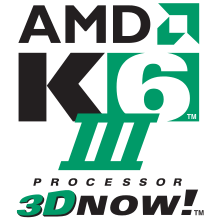K6-III+
 |
|
| Produced | From February 1999 to 2000 |
|---|---|
| Common manufacturer(s) | |
| Max. CPU clock rate | 350 MHz to 550 MHz |
| FSB speeds | 66 MHz to 100 MHz |
| Min. feature size | 0.25µm to 0.18µm |
| Instruction set | MMX, 3DNow!, Enhanced 3DNow! (K6-III+) |
| Microarchitecture | x86 |
| Cores | 1 |
| Core name(s) |
|
| Socket(s) | |
| Predecessor | K6-2 |
| Successor | K7 |
The K6-III, code-named "Sharptooth", is an x86 microprocessor manufactured by AMD, released on 22 February 1999, with 400 and 450 MHz models. It was the last Socket 7 desktop processor. For an extremely short time after its release, the fastest available desktop processor from Intel was the Pentium II 450 MHz. However, the K6-III also competed against the Pentium III "Katmai" line, released just days later on February 26. "Katmai" CPUs reached speeds of 500 MHz, slightly faster than the K6-III 450 MHz. K6-III performance was significantly improved over the K6-2 due to the addition of an on-die L2 cache running at full clock speed. When equipped with a 1MB L3 cache on the motherboard the 400 and 450 MHz K6-IIIs is claimed by Ars Technica to often outperform the more expensive Pentium III "Katmai" 450- and 500-MHz models, respectively.
In conception, the design is simple: it was a K6-2 with on-die L2 cache. In execution, however, the design was not simple, with 21.4 million transistors. The pipeline was short compared to that of the Pentium III and thus the design did not scale well past 500 MHz. Nevertheless, the K6-III 400 sold well, and the AMD K6-III 450 was clearly the fastest x86 chip on the market on introduction, comfortably outperforming AMD K6-2s and Intel Pentium IIs.
3DNow! is an extension to the x86 instruction set developed by Advanced Micro Devices (AMD). It added single instruction multiple data (SIMD) instructions to the base x86 instruction set, enabling it to perform vector processing, which improves the performance of many graphic-intensive applications. The first microprocessor to implement 3DNow was the AMD K6-2, which was introduced in 1998.
The K6-III+ had the "Enhanced 3DNow!"(Extended 3DNow! or 3DNow+) which added 5 new DSP instructions, but not the 19 new extended MMX instructions.
...
Wikipedia
